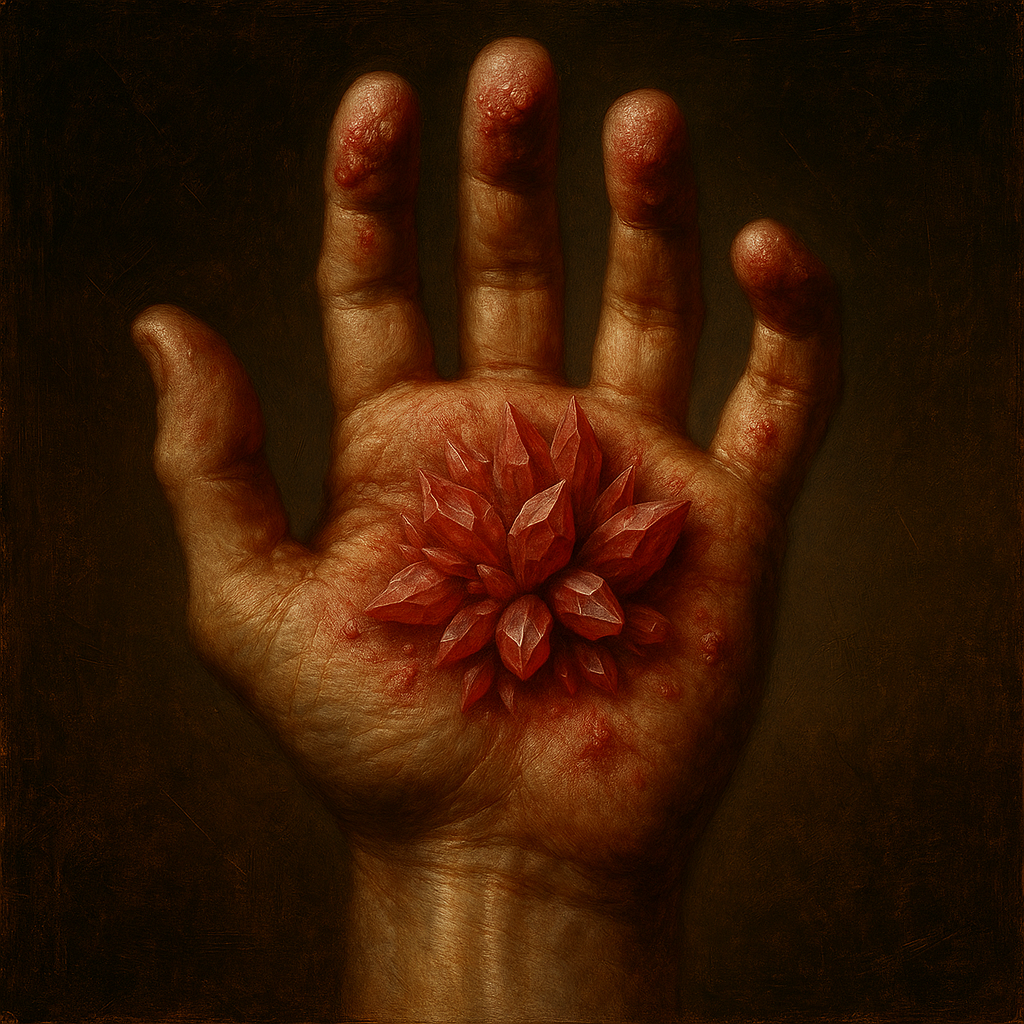Glasspox
“He begged me to pull it out. A long, twisting shard growing up from his wrist like a rose-thorn of ruby. I told him no. Told him not to move. But the fever had him. He pulled. It snapped. His scream echoed like it came from under the water, and the blood that followed looked like it wanted to be glass too.”
They say it starts with a fever, a shimmer under the skin. By the time the red shards bloom from your flesh, it’s too late to pretend you’re going to be alright. You’ll want to claw them out, but each scratch only sows more glass. Every movement cuts. Every night is blood and pressure and praying not to dream lest you spread the rash writhing in your sleep. They call it a pox, but it’s a curse, sharp and slow and hungry. Glasspox is believed to be a mutated remnant of pre-Schism pox strains, altered through prolonged exposure to magickal runoff created in its wake. Some alchemists blame cursed ritual sites or improperly sealed arcane vaults; Others whisper it was the work of desperate hedge-sorcerers trying to cure skin-rotting diseases but summoning bloodied crystals instead. Whatever its birth, the pox is now a beast of flesh and fracture, stalking lowborn districts and forgotten ruins where the air tastes faintly of copper and magick; Scratch by scratch consuming its prey from the inside until there's no blood left to bleed.
Transmission & Vectors
Contact-based, primarily via skin-on-skin friction or touch with contaminated surfaces. Infectious crystalline filaments embedded in cloth, bedding, or dead skin can spread the condition. Some rare waterborne cases have occurred in flooded districts. The disease becomes contagious once the first glass bloom (hardened red-pink shard protrusion) appears, though early-stage rashes can carry trace contagion. Do not scratch. Some people unfortunately, may be intentionally infected; Those in the captivity of royal torturers, with tighter lips on their alleged secrets, may have infected cloths or tools be placed in strategic areas around the joints, to place their victims in a perpetual state of fatigue and discomfort.
Causes
Arcano-viral hybrid strain, believed to have emerged from magickally destabilized strains of poxvirus left behind during the Schism's collapse of organized arcane medical practices. Crystallization is the result of magickal calcification in the dermis, converting bloodborne pathogens into hardened silica-glass masses. It is uncommon, but regionally epidemic. Rare in highland climates or dry regions. Known to cluster around river-sink districts, flood-prone settlements, and forgotten magickal waste sites.
Symptoms
- Persistent itching and raw-feeling skin.
- Initial rash, deep red, inflamed, irregular.
- Within days: emergence of jagged crystalline shards, ranging from pinkish to blood-red hues, erupting at points of infection.
- Internal bleeding, soreness, and lacerations caused by movement.
- Insomnia due to pain and constant pressure.
- In some cases, mild delirium, tremors, or magickal hallucinations, especially if crystals grow near nerve channels.
- Long-term: hardened callouses of fused skin and glass; can deform posture or limit limb motion.
Treatment
- Painkilling poultices (notably boglark resin and riverwine pulp).
- Surgical removal of large shards, high risk of infection or hemorrhage.
- Standard treatments often fail due to magickal calcification’s resistance to heat and salve.
- Full recovery is possible with early diagnosis, but scarring is permanent.
- Costly, and rarely prioritized in plague-quarantined districts.
Prognosis
- Non-fatal in healthy individuals, though lingering symptoms and extreme discomfort are common.
- Fatal in children, the elderly, or those with weakened blood due to blood loss, fever, or infection.
- Death often occurs not from the disease itself but from lacerated arteries, accidental self-mutilation, or fever-delirium causing patients to wander or tear at their own bodies.
Sequela
- Chronic nerve pain or numbness.
- Permanent glass-skin callouses in healed areas.
- Increased risk of infection in joints or crystal growth points.
- Survivors are prone to insomnia, paranoia, and relapsing magickal fevers.
Affected Groups
- Children, elderly, and those with weakened blood are most at risk.
- Common among laborers, riverfolk, moss-burrowed settlers, and ritual initiates.
- Unlicensed arcanists, grave-pickers, and midwives in low-lying districts are especially vulnerable.
Hosts & Carriers
- No known animal carriers, though contaminated Deathrattles' hides and bogbeast saliva have tested positive.
- Crystals can remain infectious after death, burning corpses is advised.
- Some fungal beds found in afflicted ruins bear shard-blooms, thin brittle mushrooms that resemble broken glass.
Prevention
- Avoid contact with infected persons or bedding.
- Use ash-dust gloves, ritual scarves, and avoid shared bathing or prayer-pools during outbreak seasons.
- Some travelers wear copper-threaded charms or carry slivered bone wards, efficacy unproven.
- Do not scratch under any circumstance.
Epidemiology
- Most common in dense, damp settlements, especially those with poor drainage or magickal contamination.
- Outbreaks often follow ritual festivals, floods, or necromantic spill events.
- Spread exacerbated by tight quarters and low awareness, often mistaken for common rash in early stages.
- Known “blood well” outbreaks have occurred in Newforge, Merchant's Meet, and Bordersword.
History
First recorded outbreak was in Opulence, two decades after The Great Schism. Survivors described victims bleeding from their skin "as if thrown through ten windows" Subsequent outbreaks have triggered quarantines in many Everwealthy cities. Some plague songs even mention the disease by name, "Glass for skin and red for sleep, scrape it once and dig it deep." One infamous case involved a Cleric from The Knights of All-Faith who contracted the pox while blessing plague-ridden refugees. His body was said to have erupted entirely in crimson glass and stood frozen upright, like a shattered statue mid-prayer.
Cultural Reception
- Victims are often quarantined, feared, and ostracized.
- Superstition surrounds the affliction, some believe it is punishment for greed or vanity, others claim it’s the touch of a forgotten Glass-Tulpa.
- In certain hedge-faith sects, sufferers are called “Shardsaints” and are revered as mortals briefly gifted with divine skin, though this belief is not widespread.
Origin
Magical
Cycle
Short-term
Rarity
Uncommon



Comments